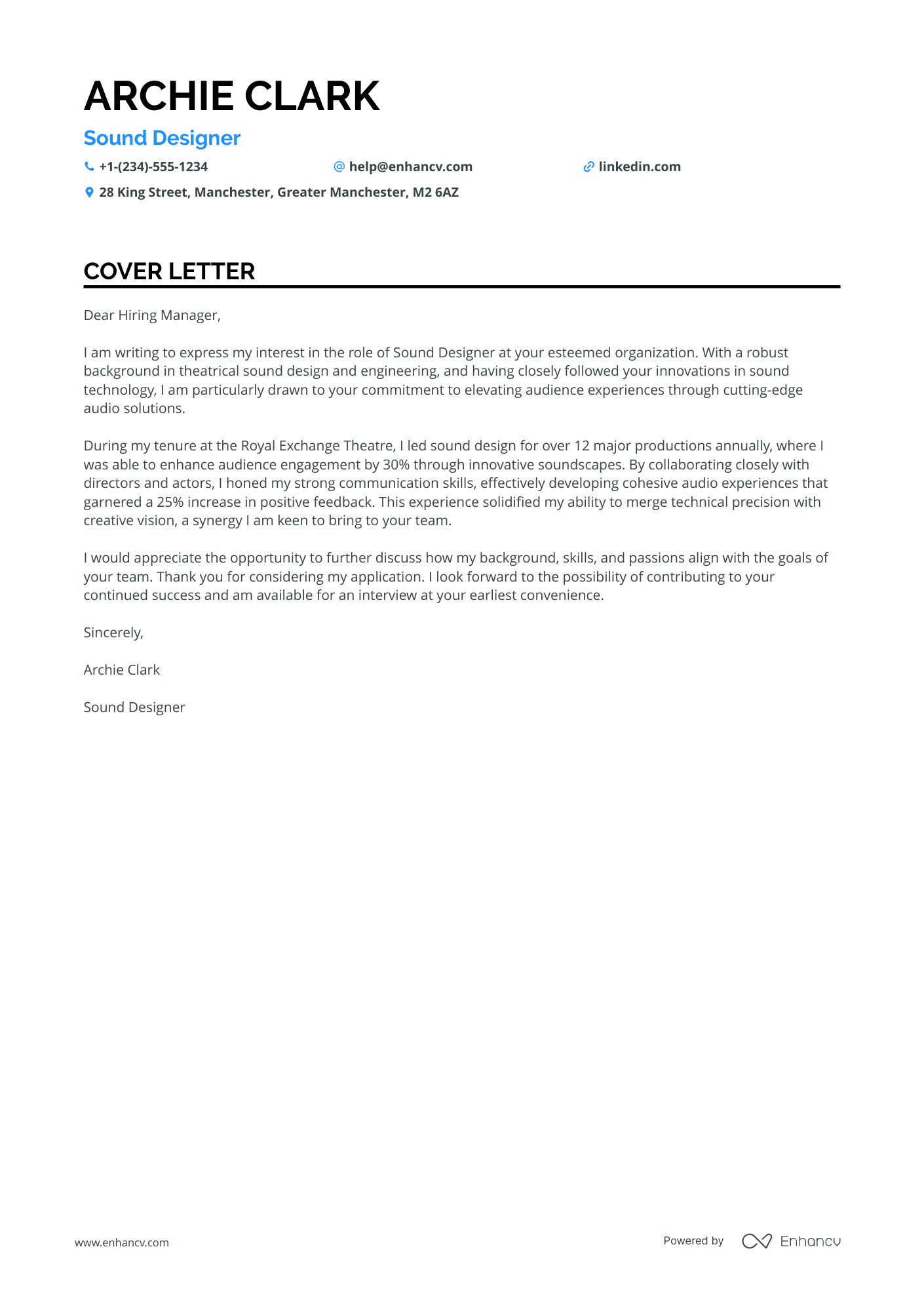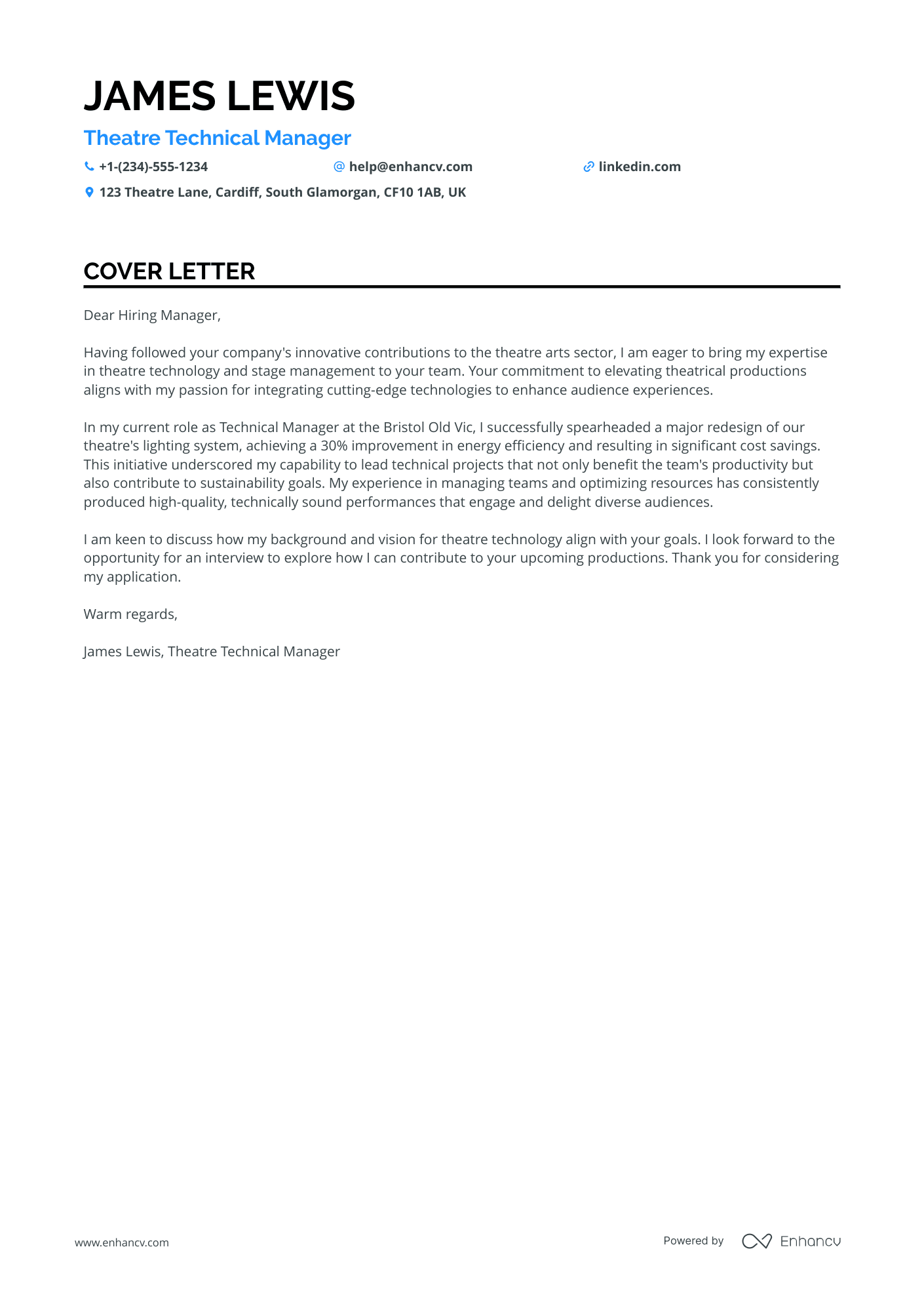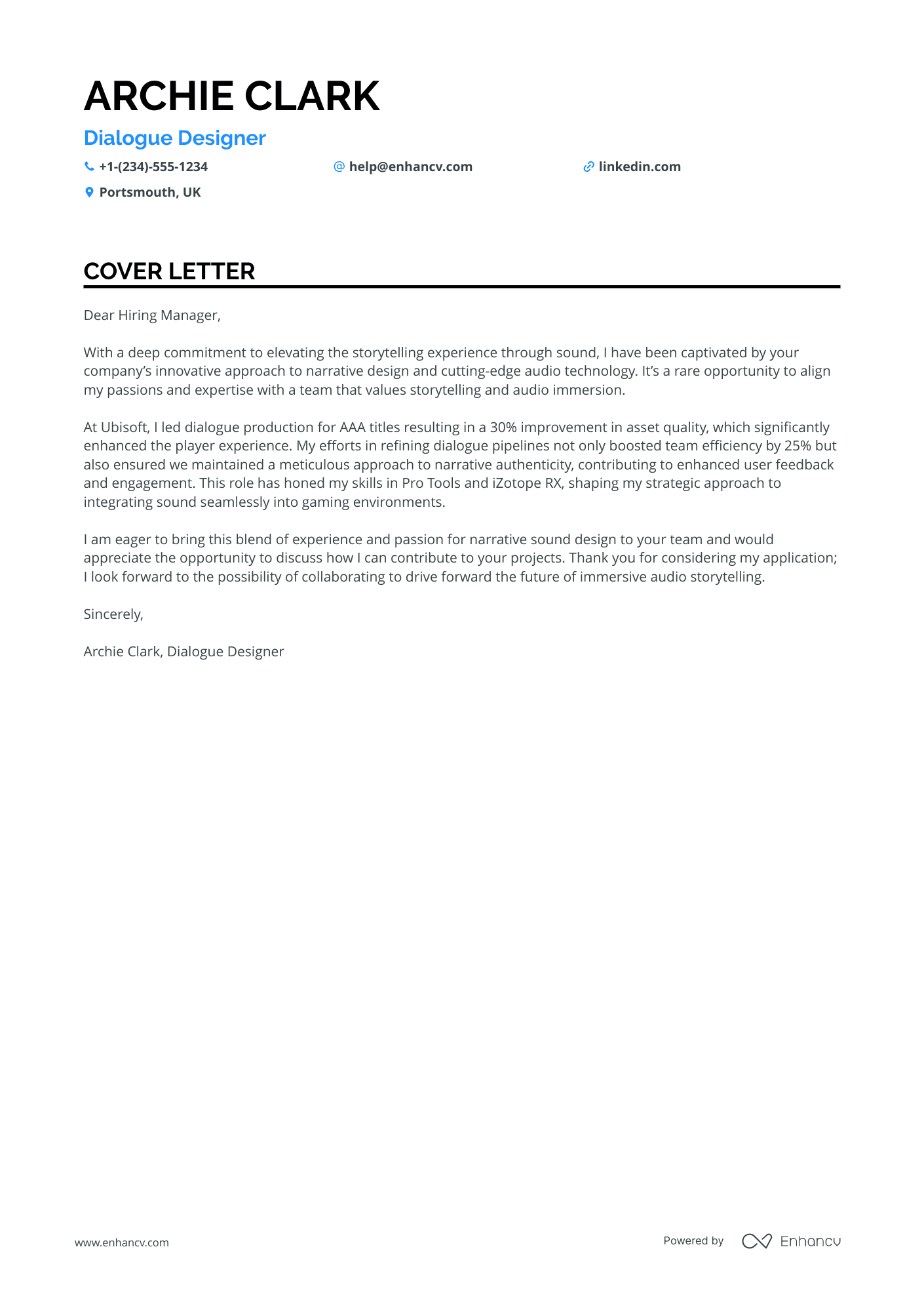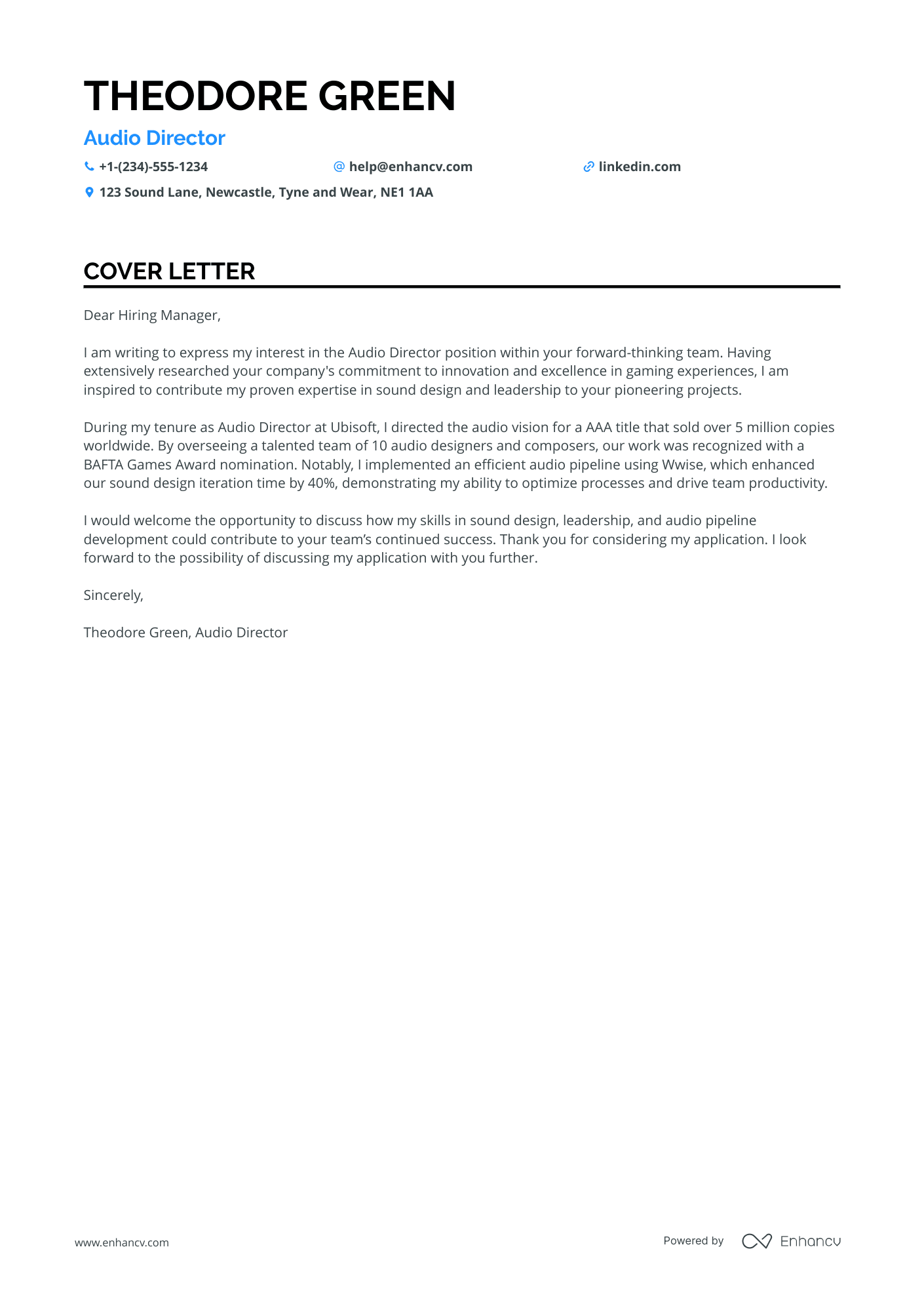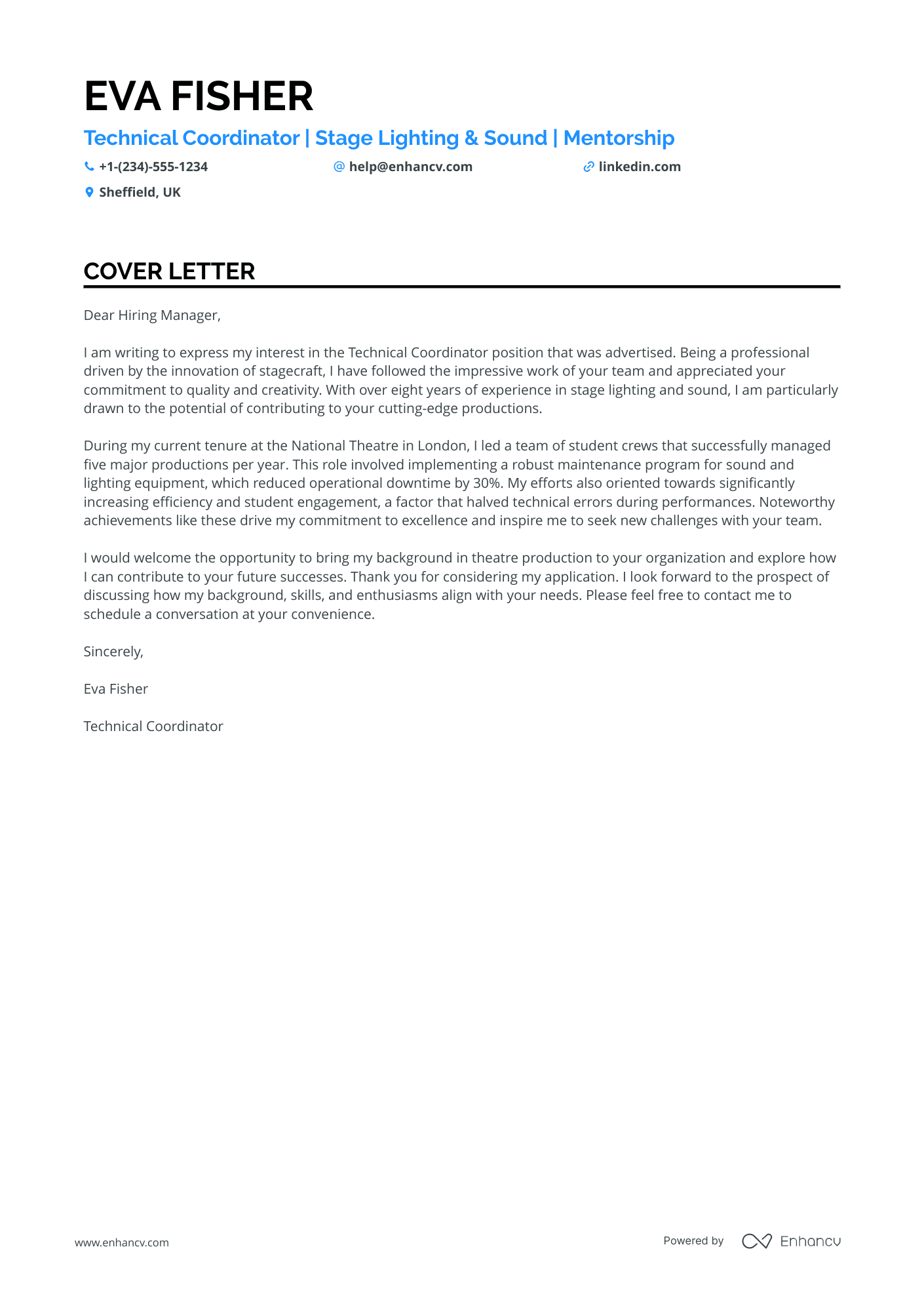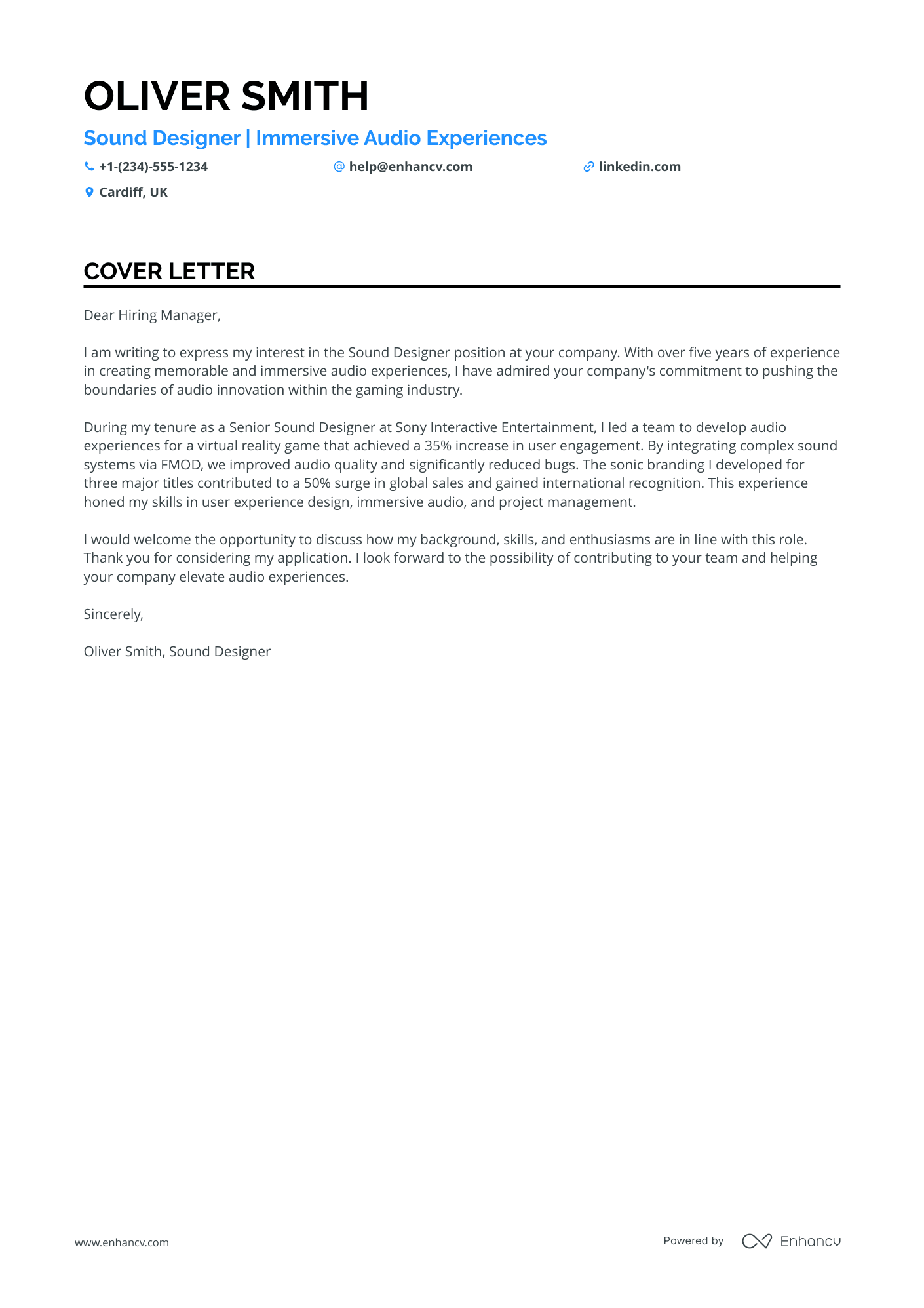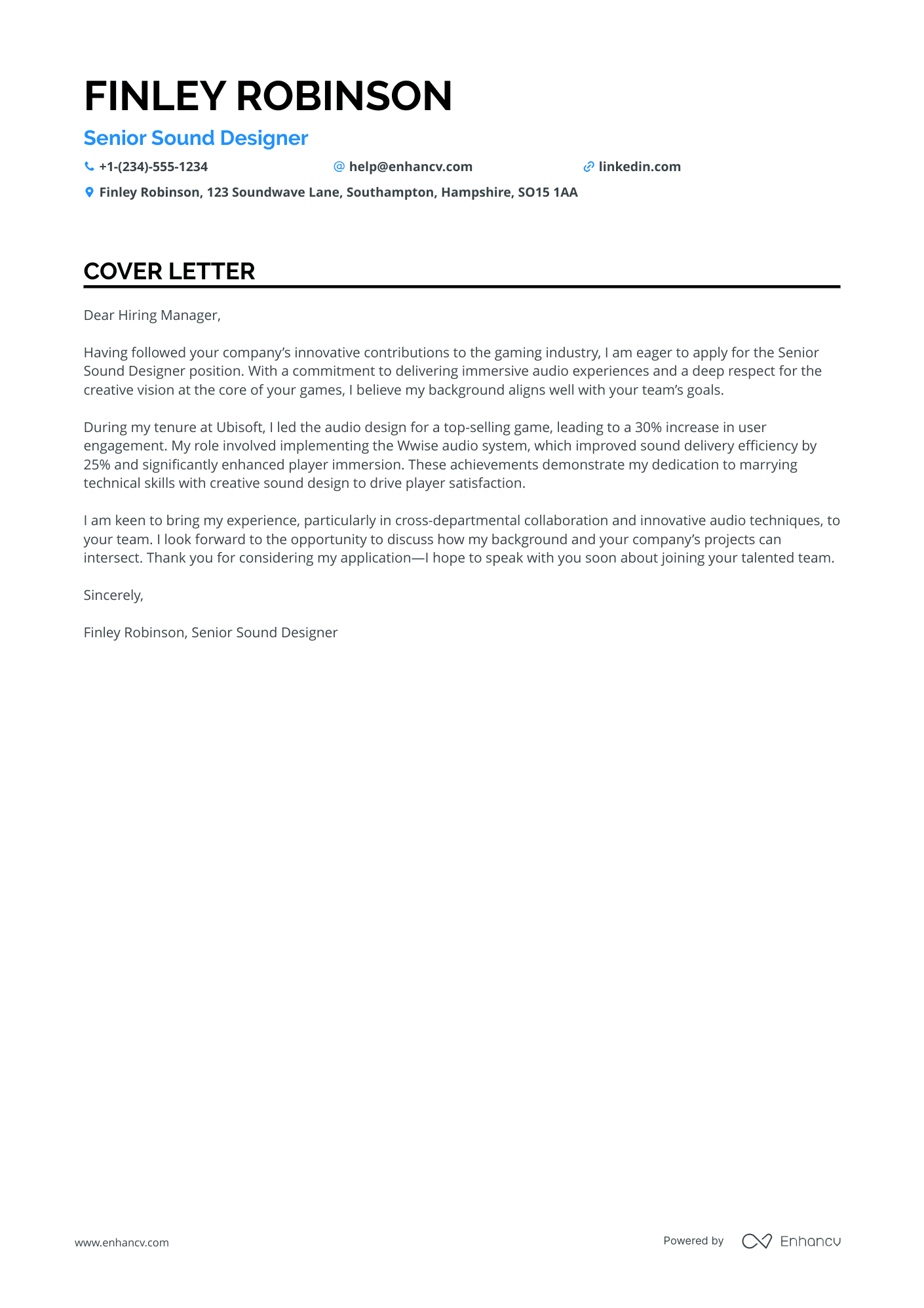When you start applying for jobs, you quickly realise that including a cover letter with your CV is a excellent way to stand out. But what should your cover letter focus on?
Should it emphasise your key achievements or simply list your responsibilities? And how can you effectively demonstrate that you're the ideal fit for the role?
One of the most common mistakes candidates make is either underselling themselves or overstating their experience.
In this guide, you’ll learn how to craft a compelling cover letter by showcasing your most significant professional achievement and telling the story behind it.
Cover letter examples for sound designer
By Experience
Junior Sound Designer
- Key Certifications: Highlighting the Wwise Certification is beneficial, as this certification underscores expertise in a specialised audio middleware tool crucial for technical sound design roles.
- Quantifiable Achievements: Presenting specific statistics, such as improving player engagement by 15% and reducing processing time by 20%, provides tangible evidence of success and impact in past roles.
- Mentorship and Leadership: Mentioning the structured mentorship programme and its positive effects demonstrates leadership qualities and the ability to nurture talent, which are valuable in collaborative team environments.
- Diverse Experience: The comprehensive experience with both Electronic Arts and Ubisoft, well-known industry leaders, adds authority and showcases versatility in handling projects of varying scope and complexity.
Senior Sound Designer
- Highlighting Relevant Experience: The cover letter effectively outlines over 15 years of experience in design management, focusing on high-value projects and achievements that align with the role of Senior Design Manager.
- Emphasising Specific Skills: Key skills such as BIM expertise, value engineering, and design management are prominently featured, underscoring the applicant's qualifications for managing complex design projects.
- Achievements and Results: The writer articulates specific accomplishments, such as increasing design efficiency by 20% and achieving zero snag deliveries, which provide tangible evidence of capabilities and past successes.
- Professional Development and Education: Mentioning relevant courses and a solid educational background strengthens the applicant's authority in the field, particularly the courses in BIM implementation and advanced risk management.
Lead Sound Designer
- Tailored Role Title: The cover letter is tailored to the role by clearly stating Alfie Edwards' role as a "Lead Sound Designer" with specialisation in RPGs, Audio Systems, and Unreal Engine, indicating relevance to potential employers in the gaming industry.
- Emphasis on Leadership and Results: The cover letter effectively highlights leadership achievements, such as leading a team at Rockstar Games to enhance game audio quality, showcasing skills in team management and the impact on project outcomes.
- Certification and Tools Proficiency: Mentions courses and skills in advanced Wwise techniques and Unreal Engine 5, which are crucial for a sound designer role in gaming, demonstrating expertise in essential industry-standard tools.
- Award-winning Experience: The inclusion of a notable achievement, such as contributing to a BAFTA-winning project's audio design, serves to underscore both artistic skill and recognition at the highest industry levels.
Assistant Sound Designer
- Highlighting Relevant Experience: The cover letter effectively underscores the candidate's extensive experience in technical coordination, which is crucial for roles in stage lighting and sound. This demonstrates both skill and a deep understanding of theatre production processes.
- Emphasising Mentorship Skills: By showcasing achievements in student training and mentorship, the cover letter presents the candidate as a resourceful professional who not only possesses technical prowess but also has the ability to guide and develop emerging talent.
- Detailing Achievements and Impact: Specific outcomes, such as a 30% reduction in downtime or increased audience engagement, provide tangible evidence of the candidate’s efficacy, adding substantial weight to the application.
- Listing Specialised Skills and Tools: Mentioning specific skills and tools like ETC Lighting Control and VectorWorks Spotlight illustrates technical expertise and familiarity with industry-standard technology, making the candidate a more attractive prospect.
By Role
Sound Designer for Film
- Technical Proficiency: Highlighting specific expertise with equipment like Allen & Heath SQ 7 and TheatreMix bolsters credibility for sound design and engineering roles, demonstrating practical knowledge and hands-on experience.
- Quantifiable Achievements: Emphasising numerical impacts such as enhancing audience engagement by 30% or reducing equipment loss by 20% provides tangible evidence of success and capability, critical for showcasing impact in performance-based roles.
- Collaborative Experience: Detailing collaboration with directors and actors to improve feedback by 25% underscores the importance of teamwork in theatrical environments, ensuring seamless and cohesive production outcomes that resonate in creative settings.
- Continuous Education and Skills Development: Mentioning targeted courses like those from Berklee College of Music and MasterClass reflects a commitment to ongoing professional development, showcasing adaptability and dedication to mastering advanced sound techniques.
Sound Designer for Video Games
- Emphasising relevant experience: Isabelle highlights her extensive experience in sound design for AAA games, showcasing her over 10 years of expertise in creating dynamic audio experiences, which is crucial for her role as Expert Sound Designer.
- Demonstrating technical skills: The cover letter details a wide range of technical skills such as 3D/Spatial Audio Formats, Audio-Control Scripting, and Game Audio Implementation Systems, which are essential competencies for sound designers in the gaming industry.
- Showcasing achievements: Isabelle includes specific achievement like leading a team to win the Award for Best Sound Design at the BAFTA Games Awards, which serves as strong evidence of her capabilities and success in the field.
- Illustrating passion and continuous learning: Isabelle mentions her passions and courses she completed, such as "Immersive Audio and Virtual Reality," indicating her dedication to staying updated with industry trends and her genuine interest in audio innovation.
Sound Designer for Theatre
- Tailored Experience: The cover letter efficiently links James Lewis's experience in managing technical teams, optimising productivity, and reducing operational errors, which directly aligns with the responsibilities of a Theatre Technical Manager.
- Quantifiable Achievements: The emphasis on specific achievements, such as a 25% reduction in production setup time and a 30% improvement in energy efficiency, reinforces his capability to deliver measurable improvements in technical theatre management.
- Relevant Skill Set: The distinct mention of advanced competencies in light and sound technologies, DMX and automated fixture programming, showcases the necessary technical expertise crucial for success in this role.
- Education and Training: Highlighting educational qualifications, like a Master of Fine Arts in Theatre Technology, and specialised courses underpins his foundation and continued education in theatre technology.
Sound Effects Designer
- Highlight Industry-relevant Certifications: Including certifications like "Professional Sound Design for Live Events" from Berklee College of Music showcases specialised knowledge and commitment to professional development in audio engineering and sound design.
- Emphasise Technical Skills and Software Proficiency: Listing expertise in specific tools such as Pro Tools, QLab, and Dante underlines technical proficiencies essential for a role in audio engineering and live mix.
- Stress Leadership and Mentoring Experience: Discussing experience in mentoring junior engineers and interns not only demonstrates leadership abilities but also highlights a proactive approach to team development and knowledge sharing.
- Showcase Impactful Achievements: Detailing achievements like a 25% increase in positive audience feedback through innovative audio solutions effectively emphasises the tangible impact and success of previous projects.
Dialogue Sound Designer
- Highlighting specialised certifications such as the "Interactive Audio Middleware Certification" underscores expertise in tools like Wwise, which is critical for a Dialogue Designer and Audio Engineer.
- Emphasising proficiency in industry-standard software such as Pro Tools and iZotope RX supports competence in essential technical skills required for sound design and audio engineering roles.
- Describing specific achievements, such as "Revamped dialogue processing systems" and the "In-house Audio Tool Creation," reflects significant contributions to improving efficiency and workflow, which can appeal to prospective employers in the gaming industry.
- Detailing experience with managing high-profile actors and leading teams on AAA titles showcases leadership and project management abilities essential for high stakes audio production environments.
Music Sound Designer
- Highlighting Specific Experience: Ruby effectively showcases her experience by listing quantifiable achievements, such as a 30% improvement in exam pass rates and a 40% increase in student engagement.
- Emphasising Relevant Skills: She places emphasis on critical skills for the role, such as "Music Theory," "Child Development," and "Curriculum Development," aligning with her qualifications and experience.
- Focus on Relevant Achievements: Ruby points out her success in increasing student retention by 50% and improving overall satisfaction by 30%, underscoring her impact and effectiveness as a music educator.
- Showcasing Passion and Commitment: The cover letter reflects her enthusiasm for music education through her listed passions, including "Youth Empowerment Through Arts" and "Continuous Learning," which speaks to her dedication to the role.
Freelance Sound Designer
- Highlighting expertise in industry-standard tools such as Pro Tools and Unity, which demonstrates technical proficiency essential for the role of a Sound Designer.
- The cover letter effectively showcases a track record of measurable success, such as enhancing user retention by 40%, which underscores the candidate's impact potential within immersive audio experiences.
- Featuring leadership experience, such as leading a team in developing audio for virtual reality games, illustrates the ability to manage projects and mentor junior designers, which is valuable for senior positions.
- Including achievements, like being awarded for innovative sound design, reinforces credibility and distinguishes the candidate in competitive job markets.
Sound Designer for Radio
- Incorporate quantifiable achievements, such as improving sound quality by 30% and reducing technical downtime by 25%, to demonstrate the impact and effectiveness in the sound engineering role.
- Highlight relevant experience in managing both live and online audio, underscoring the capability to handle large audiences, as evidenced by the management of a live-stream with over 10,000 online viewers.
- Emphasise key skills and proficiencies essential for a sound engineering role, such as troubleshooting and equipment maintenance, to showcase a well-rounded expertise.
- Include advanced education and specialised certifications in audio production to reinforce the candidate's credentials and commitment to professional development.
Sound Designer for Television
- Highlighting Achievements: The cover letter effectively details specific accomplishments, such as enhancing audio quality for award-winning projects and innovating sound effects libraries, which demonstrate proven results and value in the role.
- Reverse Chronological Experience: Listing job experiences in reverse chronological order ensures that the most recent and relevant experience is highlighted, showcasing career progression in the field of sound design.
- Technical Skill Emphasis: Emphasising proficiency in industry-standard audio tools such as Pro Tools and Logic Pro illustrates technical expertise, which is crucial for sound design and mixing roles.
- Passion Alignment: Clearly defining passions related to filmmaking, video game development, and music production aligns personal interests with professional aspirations, suggesting genuine enthusiasm for the role.
Sound Designer for Animation
- Quantifiable Achievements: The cover letter effectively highlights quantifiable successes, such as increasing client audience engagement by 40% and reducing shoot times by 30%, which showcase the candidate's impact and effectiveness in the role.
- Relevant Experience: Emphasising roles in prestigious companies like BBC Studios and Sky Studios adds credibility and demonstrates experience in high-pressure, professional environments.
- Technical Skills: The mention of advanced proficiency in Adobe Premiere indicates essential technical expertise, which is critical for a role in video editing and production.
- Educational Background: Highlighting a Master of Arts in Film Production from the University of Westminster assures the prospective employer about the candidate's academic grounding and dedication to the craft of filmmaking.
Sound Designer for Music Production
- Tailored Summary: The cover letter begins with a concise summary, emphasising the applicant's extensive experience and proficiency in relevant software such as Adobe Creative Suite, capturing the hiring manager's attention.
- Quantifiable Achievements: Throughout the cover letter, Edward includes specific data, such as increasing client satisfaction by 35% and boosting brand awareness by 30%, to demonstrate the tangible impact of his work.
- Leadership and Mentorship Skills: The cover letter highlights leadership experiences, including leading a team at Ogilvy UK and mentoring new designers, showcasing Edward’s ability to guide and enhance team performance.
- Industry Recognised Success: Achievement of an award-winning campaign demonstrates high-level success and credibility, positioning Edward as a standout candidate with proven results.
Live Event Sound Designer
- Highlighting Key Experience: The cover letter effectively showcases pivotal roles and achievements, including leadership in audio design at Ubisoft and developing a tagging system for audio assets, crucial for a Senior Sound Designer role.
- Specialised Skills and Software Knowledge: Emphasising proficiency in industry-specific software like Wwise and FMOD underlines the applicant’s technical expertise, essential for roles requiring sound implementation.
- Cross-Departmental Collaboration: Demonstrating cross-departmental teamwork in enhancing game ambience and aligning audio with narrative elements highlights the candidate’s ability to work effectively within diverse teams.
- Focus on Measurable Achievements: Quantifiable results, such as a 30% increase in user engagement, provide tangible evidence of the applicant’s impact and success, making the claims more compelling and credible.
Sound Designer for Advertising
- Emphasise specialised skills such as "Audio Pipeline Development", which aligns directly with the responsibilities of an Audio Director role.
- Highlight leadership experiences, like managing a team of 10 audio designers and composers at Ubisoft, showcasing the candidate's managerial capabilities in high-pressure environments.
- Focus on major achievements, such as a BAFTA Games Award nomination, to underline a proven track record of excellence and industry recognition.
- Mention specific tools and technologies like Wwise and Unreal 5 Engine, demonstrating technical proficiency essential for advanced sound design and integration.
Sound Designer for Podcasts
- Emphasise expertise in audio production and narrative storytelling, as these are core components of a Senior Producer role in audio narratives and journalism.
- Highlight achievements like increasing audience engagement by 40%, showcasing the applicant's ability to engage and grow an audience effectively.
- Include the development of innovative sound design elements and the integration of global perspectives, which underline creative and analytical approaches to production work.
- Showcase effective project and budget management skills, important for leading production projects within a media environment.
Sound Designer for Virtual Reality
- Relevant Experience: Highlighting extensive experience in content design and UX writing, particularly at reputable companies like Spotify and BBC, showcases a solid foundation in the field, which is crucial for the role.
- Quantifiable Achievements: Including specific metrics such as a 30% increase in user engagement and 40% improvement in product localisation efficiency underscores the candidate's ability to deliver tangible results.
- Complementary Skills: Emphasising skills in high-fidelity design, systems thinking, and Figma demonstrates proficiency in tools and methodologies that directly support effective content design strategies.
- Targeted Education: Degrees relevant to digital media and languages, including a Master's in Digital Media, show targeted academic background, aligning with career expertise and aspirations in content design.
Environmental Sound Designer
- Highlighting specific projects and achievements, such as achieving carbon reductions of 20% in commercial projects and leading material reuse initiatives, to demonstrate tangible impact and expertise in sustainable design.
- Emphasising technical proficiency in tools like Rhino and IES-VE, which are critical for roles focused on energy modelling and thermal performance analysis.
- Incorporating certifications and courses, such as those from CIBSE and the UK Green Building Council, to underscore a commitment to continuous professional development and mastery of cutting-edge techniques.
- Stressing collaborative experiences, like working with architects and leading training programmes, to demonstrate the candidate's capacity to enhance team performance and integrate sustainable practices across disciplines.
Sound Designer cover letter example
Archie Clark
[object Object]
+44 1234 567890
help@enhancv.com
- Highlight Industry-Specific Experience: Mentioning over 12 years of experience as a Sound Designer establishes credibility and aligns the applicant's background with the needs of the industry.
- Showcase Technical and Leadership Skills: Discussing the development of proprietary sound tools highlights both technical skills and the ability to lead innovative projects, which are crucial for advancing audio in gaming.
- Quantify Achievements: Using metrics like a 20% increase in productivity and a 15% boost in user engagement helps demonstrate the impact of the applicant's contributions in previous roles.
- Align with Company's Values: Expressing admiration for the company's innovation highlights the applicant's alignment with the company's ethos and positions them as a culturally fit candidate.
Importance of cover letters in the United Kingdom
Cover letters are a crucial part of your application, offering additional details beyond your CV.
Here’s why they’re essential:
- Supporting your CV: Now's your opportunity to provide some context for your experience, with more information on your key achievements and how your profile could benefit the position and organisation to which you're applying.
- Showcases your character: Taking the time to write a cover letter demonstrates that you’re proactive, organised, ambitious, and genuinely interested in the role.
- Reflects your career goals: Use the cover letter to outline your long-term career career aspirations and how this role aligns with your broader plans.
What UK employers expect from a cover letter
You only have one chance to impress your potential UK employers, so be wise about writing your cover letter.
When doing so, follow these three simple but essential steps:
- Do your research: Begin by researching the company and the role you're applying for. Check their website, social media pages, and relevant news to understand what drives their business.
- Highlight company values: Identify the company's core beliefs and explain how your personal and professional experiences resonate with them. For instance, if the organisation prioritises innovation, provide examples where you've demonstrated creative thinking.
- Match your skills to the job: Analyse the job description carefully and pick out the most important skills or qualifications they’re seeking. Be sure to mention your relevant achievements that prove you're the perfect fit for the position.
How to format a sound designer cover letter
Have you ever wondered about the formatting and structure of your cover letter?
Read on to discover some guidance from industry-leading professionals:
- Within the header, include your address and contact details, the employer's name and address, and the date, followed up by a personalised salutation.
- The body should should consist of an opening paragraph, middle paragraphs expanding on your unique experience and skills, and a closing paragraph.
- End with a formal sign-off and your signature.
- Choose modern fonts such as Volkhov, Chivo, or Bitter instead of the more traditional Arial or Times New Roman.
- All of ENhancv's templates maintain single-spacing with approximately 1-inch (2.5 cm) margins on all sides to ensure a neat presentation.
- Always send your cover letter as a PDF to keep the formatting intact and prevent any edits once submitted.
Your CV and cover letter maintain consistent formatting. Use the same fonts, margins, and style to create a professional and cohesive look for your application.
Finally, remember that Applicant Tracking Systems (the software some companies use to align job keywords to your experience, also known as ATS) do not read cover letters–it's intended solely for recruiters. Make it stand out by highlighting your achievements and relevant skills for the role.
How to write your sound designer cover letter salutation
In a world of AI and instant prompts, taking the extra time to personalise your cover letter truly makes a difference.
Address the hiring manager directly with a customised greeting (e.g., 'Dear Mr Bond', 'Dear Ms Penny').
You can often find their name on LinkedIn (under the job listing or by searching) or in the ‘About’ or ‘Meet the Team’ section of the company's website. If in doubt, you can also contact the reception for assistance.
If you can't find the name, rather than using 'Dear Sir or Madam', opt for something more personal, such as 'Dear [Company Name] Hiring Manager'.
How to write your sound designer cover letter intro
While your cover letter should remain professional, adding a touch of personality or humour can make you stand out.
Hiring managers sift through countless applications, day in and day out. Anything unique or personable that grabs their attention could give you a competitive edge.
But do your homework first to ensure a dash of creativity would be appropriate and suitable to the company culture.
How to write your sound designer cover letter body
A well-written cover letter body goes beyond the content of your CV, expanding on your greatest achievement to form your compelling case.
The narrative you tell within it could focus on a few key elements:
- A concrete and noteworthy achievement: Backed by data and relevant to the job.
- Your hard and soft skills: Presented with measurable outcomes and results.
- A successful project: Showing how you contributed to the final result.
The goal is to tell a story that aligns with the company’s needs and adds a more human touch to your application.
How to write a closing paragraph
There’s a wrong and a right way to close your cover letter. Here’s how.
The wrong way is to end with a signature or a formal 'Thank you in advance.'
The right way is to either promise how you’d make a positive impact on the company or ask when you can expect a response. This will highlight you as a forward-thinking candidate who’s enthusiastic about securing the role.
Conclusion
Your cover letter is an opportunity to showcase your personality and skills to potential employers. Start by addressing the hiring manager by name and tailoring your content to reflect the role’s requirements.
Include a specific example of your greatest achievement to illustrate your suitability for the position, while also expressing your enthusiasm for the company. Remember to format your letter professionally, ensuring it aligns seamlessly with your CV.




